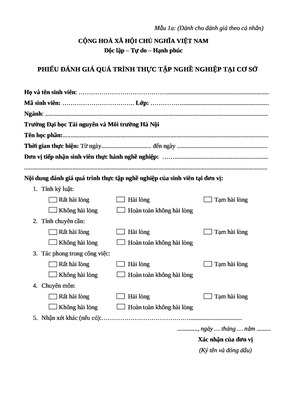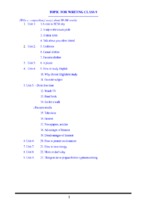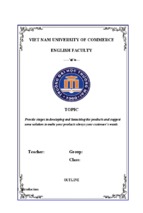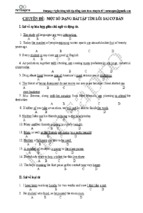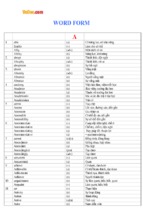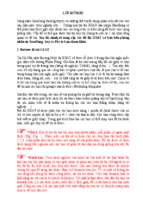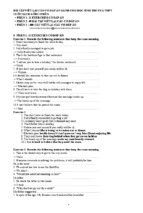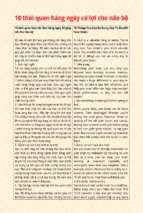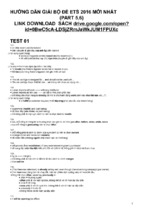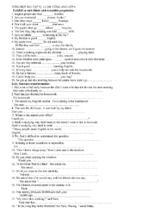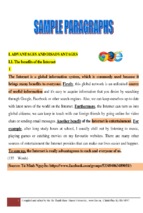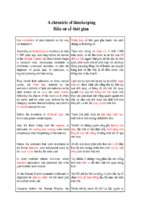1
2
MINISTRY OF EDUCATION AND TRAINING
The thesis has been completed at the College of Foreign
UNIVERSITY OF DANANG
Languages, Danang University
Supervisor: Assoc. Prof. Dr. PHAN VĂN HÒA
NGUYỄN THỊ XUÂN MỸ
Examiner 1: Assoc. Prof. Dr. NGÔ ĐÌNH PHƯƠNG
AN INVESTIGATION INTO PROJECTING
PROCESSES IN ENGLISH AND VIETNAMESE
SHORT STORIES AND NOVELS
Examiner 2: Ph.D. HỒ THỊ KIỀU OANH
Field Study: THE ENGLISH LANGUAGE
Code
: 60.22.15
The thesis to be orally defended at the Examining Committee.
Time: 29/10/2012
Venue: Danang University
MASTER THESIS IN THE ENGLISH LANGUAGE
This thesis is available found at the libraries of :
DANANG, 2012
- Information Resources, University of Da Nang.
- College of Foreing Langueges, University of Da Nang.
3
4
CHAPTER 1: INTRODUCTION
projection. “An Investigation into Projecting Processes in English
and Vietnamese Short Stories and Novels” turns out to be a ‘should’
1.1. RATIONALE
to deal with. Really, studying Mental process (MeP) and Verbal
Grammar is always an important part in learning and
process (VeP), two processes which can project, promises a practical
teaching a language in general and a foreign language in particular.
application in language use, contributing much to the teaching and
Functional grammar (FG), the grammar focusing on communication
learning English as a foreign language.
appears to be much vital in the new tendency of studying where the
1.2. AIMS OF THE STUDY
communicative approach is appreciated. Unlike traditional grammar,
• help Vietnamese learners to know well the nature of the
FG does not break a clause up into discrete parts but links words that
two projecting processes: MePs and VePs in English and
share a purpose. Its orientation is social rather than biological. This is
Vietnamese short stories and novels.
a view of grammar ‘at work’, rather than a view of grammar as form.
It is a view of grammar in talk, in action, in progress - grammar being
used - and, above all, a view of grammar as meaning. It helps to
explain the design of grammar, why grammar is the way it is.
• analyze the similarities and differences between the two
processes in terms of projection.
• offer some suggestions for learning and teaching.
1.3. OBJECTIVES OF THE STUDY
Emphasizing on use, communicative function, and the social context
• formulate a deep theoretical and more importantly, a
of language, FG differs significantly from other linguistic theories in
practical background insight into the characteristics of
the way that it aims at a maximum of practical applicability in the
MePs and VePs in short stories and novels.
analysis of diverse aspect of language and language use.
There is no doubt that FG has had a very positive effect on
language teaching over the years. Thus, so many studies focus on
aspects of FG. Walks of the three linguistic metafunctions become
• analyze and point out the similarities as well as differences
between MePs and VePs as projecting processes in English
and Vietnamese short stories and novels.
1.4. THE SIGNIFICATION OF THE STUDY
the topics for research at all levels. Above all, the six processes of the
To some extent, the research can help Vietnamese learners of
transitivity system attracts much attention from researchers. Both
English to get a better insight into the framework and nature of
major and minor processes in nature have been analyzed individually
projecting processes and how these kinds of process are used in short
in a thorough way. However there have not been any studies making
stories and novels. Besides, the research will also help to raise the
a comparison and contrast between a couple of processes in an
importance of FG among the grammatical paradigms in an attempt to
aspect. Hence, this study has the ambition to carry out this
make FG closer to Vietnamese study.
intereseting view, observing a major and a minor process in terms of
5
1.5. THE SCOPE OF THE STUDY
6
CHAPTER 2: LITERATURE REVIEW
The study focuses on investigating MePs and VePs as
projecting processes and just examining them in short stories and
2.1. THE REVIEW OF PRIOR RESEARCH
novels. The main focus of the study lies in the description and
It might be said that projection attracts much researchers’
analysis of MePs ans VePs in English and Vietnamese short stories
attention. In the light of Hallidayan approach, a sentence is
and novels. For the sake of examining the characteristics of these two
interpreted as clause complex and clauses in projection can be of
processes and finding the similarities as well as differences between
equal status (Verbal) if the projected clause is quoted or of unequal
them.
status (Mental) if the clause is reported.
1.6. RESEARCH QUESTIONS
Martin [12] views the role of Projection as means used in
1. What are the nature of projecting processes?
narrative to construe the dialogic passages to represent the character
2. What are the similarities and differences of projecting
processes of consciences. He says Projection typically concerns the
processes in English and Vietnamese short stories and novels?
relation between a mental or verbal process and the content which is
3. What implications does the study have for Vietnamese
quoted or reported. Sharing the same point of view, Angela Downing
teachers and learners of English?
and Philip Locke [4] claims that the Projection is the relationship
1.7. THE ORGANIZATION OF THE STUDY
This thesis is designed in five chapters.
Chapter 1: The introduction.
which between a clause containing a verb of saying or thinking and a
clause which expresses what is said or thought.
In “Ngữ pháp kinh nghiệm của cú Tiếng Việt, mô tả theo quan
Chapter 2: Literature review and theoretical background.
ñiểm chức năng hệ thống”, Hoàng Văn Vân [31] addresses the
Chapter 3: Methods and procedures of the study.
concept ‘projection’ as one of the most important grammatical
Chapter 4: Findings and discussion.
categories in every language, and attempts to describe and explain the
Chapter 5: The conclusion of the study.
Vietnamese projecting processes in systemic functional approach. He
presents major types of Vietnamese Projection and gives us some
distinctive features. “Ngôn ngữ học ñối chiếu cú pháp Tiếng AnhTiếng Việt” [2007] by Trần Hữu Mạnh mentions about lexical verbs
and their classification in six processes, among them verbal process
verbs and mental process verbs are concerned in a special way. In his
recent study [2008]:“Hệ thống từ nối biểu thị quan hệ logic-ngữ
nghĩa trong Tiếng Anh và Tiếng Việt”, Phan Văn Hòa suggests a
7
8
system of connectors in English and Vietnamese. His research help
The process is realized by a verbal group, the participant by a
us use connectors such as “that, if, whether” in English and “rằng, là,
nominal group and the circumstance by an adverbial group or a
liệu rằng” in Vietnamese in Mental Projection appropriately.
prepositional phrase as illustrated by Halliday [1994].
2.2. THEORETICAL BACKGROUND
Table 2.1. Typical function of group and phrase clauses
2.2.1. An Overview of Systemic Functional Linguistics (SFL)
Type of element
Typically realized by
Systemic Functional Linguistics is a theory interested in
Process
Verbal group
describing language in terms of its semantic function in the social
Participant
Nominal group
and cultural contexts within which it is put to use by speakers. In this
Circumstance
Adverbial group or prepositional group
way it differs from the formal, syntactic approach of traditional
2.2.3.2. Process Types
grammars. Halliday [1978], a major figure in the development of
In the transitivity system, six processes types are recognized.
SFL, describes language as a social semiotic. According to Butt et al
- MaPs are processes of doing or action.
[2000], it means that community of speakers share knowledge about
- MePs are processes of cognition, perception, and affection.
systems of sound and writing, about lexicogrammar, meaning and
- Relational processes are processes in which a relationship is
about situations.
2.2.2. Linguistic Metafunctions
Metafunction refers to the different modes of meaning
construed by the grammar.
i. We use language to talk about our experience of the world.
This function is known as ideational metafunction.
ii. We use language to interact with other people. This
established between two terms.
- Behavioral processes construe philosophical or psychological
behavior.
- Verbal processes are processes of saying.
- Existential processes represent that something exists or happens.
2.3. PROJECTION
Projection can be briefly explained that the systemic
function is interpersonal one.
interpretation of clause complex relations (how one clause relates to
iii. We use language to organize our message. Textual
another) differs from that of many other grammatical approaches.
function is realized in this way.
Projection is one kind of what Halliday calls the logical relationships
The first two metafunctions orient towards two 'extra-linguistic'
that can hold relation between adjacent relationship clauses. In
phenomena, the social world and the natural world while the third
functional grammar, they are respectively called projecting and
metafunction, the textual metafunction is intrinsic to language.
projected clauses (Halliday [6]; Eggins [5]; Bloor [1]). The
2.2.3. The Grammar of Experiential Meaning
projecting clause is the clause, which contains the mental or verbal
2.2.3.1. Process, Participant and Circumstance
process verb, and it may occur before or after the projected clause.
9
10
The two clauses which are in a projection relationship may be
CHAPTER 3: METHODS AND PROCEDURES
dependent upon each other or independent. If they are dependent, we
have what we may call reporting; if independent, then quoting.
3.1. RESEARCH DESIGN
2.4. TYPES OF INTERDEPENDENCY IN PROJECTION
In order to achieve the set goal, the study will be carried out by
2.4.1. Parataxis and Hypotaxis
the combination of descriptive, quantitive and qualitative approaches.
The two clauses in the projection relationship can be dependent
The analysis of projecting processes in English and Vietnamese is
on each other or independent. They are functionally described as
based on the description of types of the processes in trantivity system
taxis and called parataxis and hypotaxis.
listed by Halliday in the view of Functional Grammar. Analysis and
2.4.2. Dependent and Embedded Projections
statistic information is paid attention to reach the conclusion of the
According to Halliday [6], embedding is a mechanism whereby
research.
a clause or phrase comes to function as a constituent within the
structure of a group, which itself is a constituent of a clause.
3.2. RESEARCH METHODS
A careful combination of deductive and inductive method will
The following analysis highlights the difference:
be employed to carry out this research. Also, descriptive method will
be used to analyze the features of MePs and VePs. We carry out the
He himself drew the conclusion [[that there was no real difference.]]
Thing
[[
Qualifier
]]
study by describing and analyzing the characteristics of the two
processes in English and Vietnamese short stories as well as novels
from the parameters established in chapter 1.
He himself concluded
α
║ that there was no real difference.
║
β
[1, p.208]
In addition, to reach the aim of finding out the similarities and
difference of MePs and VePs as projecting processes, the functional
contrastive analysis is employed to carry out this research.
What is more, English is chosen as source language and
Vietnamese as target language because the former is extensively
explored in the systemic functional model.
3.3. DATA COLLECTION AND ANALYSIS
In terms of sources, the corpus with 400 examples in English
and the same number in Vietnamese are collected randomly and
mainly from selected short stories and novels in the 20th century, both
monolingual and bilingual. Other data serving the research mainly
11
12
comes from works by Functional grammarians such as Halliday,
CHAPTER 4: FINDINGS AND DISCUSSION
Thompson, Martin, Hoàng Văn Vân, etc.
After collected, the data will be analyzed with general methods
(describing,
classifying,
generalizing,
qualitative,
In this chapter, an attempt is made to look at VePs and MePs
quantitative
in English and Vietnamese. A description of all the components of
method) and specialized linguistic method (functional contrastive
the two process types including the process, the participants, and the
analysis).
circumstances will be given. In addition, the potential of projection,
3.4. PROCEDURES
which is one of the most distinctive features of the VePs and MePs
The steps involved are to
•
Describe and analyze the process itself, the
are also explored.
4.1. VEPS IN ENGLISH AND VIETNAMESE
participants of VePs and MePs which make a very
4.1.1. The Process
important role in viewing the two processes as
When the process of the two languages is taken into more
projecting ones.
careful consideration, some differences are found. From the analysis
Make a comparison to find out the similarities and
of 400 verbal clauses taken from novels and short stories , the study
differences of VePs in English and Vietnamese in
finds out that while in English the VeP, especially the verbal
aspect of projection.
projecting complex, is preferably encoded by the neutral verb ‘say’, a
In a parallel way, make a comparison to find out the
very wide range of saying verbs can be used to realize the VeP in
similarities and differences of MePs as projecting
Vietnamese. 220 clauses out of 400 clauses of VeP in English of the
processes in the two languages.
research have the neutral verb ‘say’, accouting for nearly 55% of the
•
Discuss the findings.
total occurrence, whereas the use of the equivalent neutral verb ‘nói’
•
Provide some suggestions for the process of teaching
in Vietnamese is not the most chosen in expressing the process (only
and learning as well as further study of the issue.
40 clauses out of 400, accouting for 10%). This can be illustrated in
•
•
the following table.
13
14
Table 4.1. Result of Survey on VePs Encoded by Various Kinds of
Verbs in English and in Vietnamese
He
asked
me
Anh
hỏi
tôi
to give him a lift
to the station.
cho anh ấy ñi quá
VePs encoded
VePs realized by
Total
by neutral verb
other kinds of
occurrence of
‘say’
verbs of saying
VePs
Sayer
Pro: verbal
Receiver
Verbiage
In English
220 (55%)
180 (45%)
400
( Phát ngôn
(QT: phát
(Tiếp ngôn
(Ngôn thể)
In Vietnamese
40 (10%)
360 (90%)
400
thể)
ngôn)
thể)
gian ñến sân ga.
[7, p.462]
4.1.2. The Participants
4.1.2.3 The Verbiage
4.1.2.1. The Sayer
There are not many differences in identifying the roles of the
The Sayer is the particiant that has a very special relationship
with the VeP. Being treated as a symbolic source, the Sayer does not
have to be conscious participant, but anything putting out a signal.
Verbiage in both English and Vietnamese. Let us look at the
following example.
Please tell
me
the truth.
That sign
says:
‘No entry.’
Làm ơn nói
(cho) tôi
sự thật
Tấm biển ñó
báo
‘Vô phận sự miễn vào.’
Pro: verbal
Receiver
Verbiage
Sayer
Pro: verbal
Projected
(QT: phát ngôn)
(Tiếp ngôn thể)
(Ngôn thể)
(Phát ngôn thể)
(QT: phát ngôn)
(Được phóng chiếu)
[6, p.67]
[2, p.84]
It can be seen from the above examples that the Verbiage in
4.1.2.2. The Receiver
both English and Vietnamese functions as what is said such as the
In both English and Vietnamese, the Receiver in the VeP is
truth (sự thật). According to Nguyễn Tài Cẩn [21, p.293], the verbs
the participant to whom the saying is addressed. In fact, a verbal
of saying in Vietnamese can go with both the modifier indicating the
action does not only contain the complex of Sayer - Process: verbal
name of saying and the modifier indicating the content of saying.
but also another participant which is a person and other entity which
4.1.2.4. The Target
the saying or what is said is addressed.
One more participant of the process studied in the research is
the Target. As mentioned above, the Target is the entity that is
targeted by the process of saying. In the clause, the target is usually
identified by the verbs such as praise (khen tặng), insult (lăng mạ),
15
16
abuse (sỉ nhục), slande (gièm pha), flatter (nịnh nọt), blame (khiển
trách), criticize (chỉ trích).
4.1.3.
4.2. MEPS IN ENGLISH AND VIETNAMESE
4.2.1. The Process
Circumstances in VePs
It might be said that the framework of a MeP in English is
Most of the circumstances of the VePs in English are similar
generally similar to that in Vietnamese. They both typically begin
to those in Vietnamese. Their meaning and the grammatical functions
with a Senser which is followed by a MeP verb, which is in turn
are almost the same.
followed by a Phenomenon.
4.1.3.1. Circumstances of Matter
4.2.1.1. MePs of Cognition
Like the circumstances of Matter in English, Vietnamese
Cognition processes are realized by verbs such as know (biết),
circumstances of Matter are explored to specified the matter or the
understand (hiểu), believe (tin tưởng), remember (nhớ), forget
topic. It is typically realized by về (on, of) liên quan ñến (concerning
(quên), think (nghĩ), etc. For example:
of)...in the clauses.
I believe God was there with me that day.
They
are talking
about many things.
Họ
ñang thảo luận
về nhiều ñiều.
Sayer
Process: Verbal
Circumstance: Matter
(Phát ngôn thể)
(Qt: phát ngôn)
(chu cảnh: vấn ñề)
[5, p.253]
[34, p.125]
4.2.1.2. MePs of Affection
MePs of Affection is defined as processes expressing human’s
emotions like wishing, hoping, desiring, liking, fearing, etc. It can be
further divided into two sub-categories namely Reaction (with the verb
4.1.3.2. Circumstance of Angle
like liking, fearing, hating, etc.) and Desideration (with verbs like
Like the circumstance of Matter, the circumstance of Angle
wanting, desiring, wishing, etc.).
has also a close relationship with the VeP in both English and
4.2.1.3. MePs of Perception
Vietnamese. The preposition to (theo) is the simplest use in this
In the aspect of semantics, perceptive processes are defined as
function. However, it is often expressed by a more complex form
processes indicating perceptive activities of human beings like seeing
such as: according to (theo), in the view/opinion of (theo quan ñiểm/
(nhìn thấy), hearing (nghe thấy), finding (tìm thấy), discovering (phát
theo ý), from the stand point of (từ quan ñiểm của)….
hiện ra), smelling (ngửi thấy), etc.
Mr. Mendon saw a letter crushed into the small ball on the floor.
Theo quan ñiểm của tôi
tôi
nghĩ (rằng)…
In my opinion
I
think (that)…
Chu cảnh: quan ñiểm
Cảm thể
QT: Tinh thần
(Circumstance: angle)
(Senser)
(Pro: mental)
(Ông Mendon nhìn thấy trên sàn nhà một lá thư ñược vò tròn.)
[43, p.240]
17
18
4.2.2. The participants
c. Phenomenon of Perception
4.2.2.1. The Active Participant: Senser
A perception process can be followed by either one of all three
a. Senser of Cognition
types of phenomenon: simple phenomenon, macrophenomenon or
Senser of Cognition process is realized by a nominal group
denoting a being endowed with consciousness.
metaphenomenon.
4.2.2.3. Reversibility
His mare knew the way.
[42, p.80]
a. Reversibility of Cognition
Con dê tưởng buổi trưa Hốt phải về cho nó ăn.
[63, p.249]
b. Reversibility of Affection
b. Senser of Affection
c. Reversibility of Perception
Senser is one of the constraint participants of Affection process that
likes, hates, enjoys, misses…
Many people would miss you if you die.
Hoàng Văn Vân [31, p.278] affirms this is one of the criterion
[43, p.132]
c. Senser of Perception
distinguishing MePs from other processes. Actually, this kind of
process has a strict co-existence with circumstances, especially those
The Senser of Perception process is realized by a nominal
group denoting a being endowed with consciousness.
of the two sub-types: affection and cognition. If VePs often
collocates with circumstances of Matter and Angle, MePs are found
4.2.2.2. The non-active Participant: Phenomenon
to be with Circumstantial manner of intensification.
a. Phenomenon of Cognition
Accordingly, the meaning of intensification is illustrated with
The Phenomenon of cognition is that which is thought, known,
believed…by the conscious Senser.
…But they don’t understand true love.
4.2.3. Circumstances in MePs
so, very, extremely, rather, etc.
“I feel very tired,” he said.
[44, p.108]
…Nhưng họ không hiểu thế nào là tình yêu thật sự.
[44, p.106]
In an equivalent way, they are rất, lắm, nhiều, nhiều lắm, nhiều
lắm lắm in Vietnamese.
[44, p.59]
b. Phenomenon of Affection
Affection processes cannot be followed by macrophenomenon
Bu
rất
thương
thằng Hòa.
Cảm thể
Chu cảnh
QT: tinh thần
Hiện tượng
but only either simple phenomenon or metaphenomenon. For example:
He enjoyed making me look like a fool.
[43, p.126]
[31, p.279]
4.3. PROJECTION
4.3.1. The Concept of Projection
Projection is defined as a kind of the logical relationships that
can hold between adjacent clauses of which one clause projects a
19
20
second clause. They are respectively called projecting and projected
clauses. They are not in the relationship of constituency: the
projected clause is not a constituent of the projecting clause.
4.3.2. Verbal Projection in English and Vietnamese
- The quoting and reporting in both languages can be of a
proposition a proposal.
- Verbs of behaving in both languages can be used as a mean to
attach to VePs and introduce the projection.
4.3.2.1. Projecting Propositions
4.3.2.4. Differences
Many verbs that assign interpersonal and/ or behavioral features
- When quoting a speech, the Vietnamese quoting verbs are
to the speech events, and are used to quote especially in narrative
more varied than those in English. While the general verb say in
contexts, are never used to report because they do not contain the
English is the main verb to introduce the quoting of all moods, verbs
feature SAY.
of various kinds in Vietnamese are exploited to project a speech of all
Table 4.7. Verbs Serving as Process in Verbal Clauses Reporting
Propositions
- In reporting, the Vietnamese verbal projection does not
Proposition
(1) General
language.
say, tell
(b) demanding
ask
4.3.3. Mental Projection in English and Vietnamese
insinuate (ám chỉ), imply (hàm
A MeP is able to have a clause attached which either quotes
chỉ), hypothesize (giả thuyết),
directly someone’s thoughts (1quoting - 2quoted) or reports
claim (khẳng ñịnh)
indirectly someone’s ideas (α reporting - β reported).
(a) giving
function
Minor
undergo the shifts of tense because this is not a category of the
(a) giving
(2) Elaborating
speech
moods.
(b) demanding
Table 4.9. MeP: Parataxis - Quoting
enquire, assert
4.3.2.2. Projecting Proposal: Offers and Commands
He thought,
“We were good friends”
1 Quoting
2 Quoted
Besides the projection of proposition, i.e statement and
[51, p.128]
questions, another type of clause is also projected named proposals
Table 4.10. MeP: Hypotaxis - Reporting
including offers and commands.
4.3.2.3. Similarities
I thought
the difficulty but I think different now.
- Both English and Vietnamese VePs can project a locution as
a wording (the quoting) or as a meaning (the reporting).
that it was going to be easy enough to overcome
α Reporting
-The taxis relationship between the projecting and the projected
clauses in both languages are of parataxis and hypotaxis.
β Reported
[42, p.41]
Projection of MePs in Vietnamese can also be of two modes:
Quoting and Reporting.
21
22
Table 4.11. MeP: Parataxis - Quoting
Phong nghĩ thầm:
4.4. VERBAL PROJECTION AND MENTAL PROJECTION:
“Lão này ñểu. Thế mà cứ giả nghèo giả
khổ. Lúc nào cũng vay tiền mình”
1 Quoting
English and Vietnamese short stories and novels have many things in
common.
Table 4.12. MeP: Hypotaxis - Reporting
nó ñẻ năm tý, năm tì, tị gì …
α Reporting
4.4.1. Similarities
It might be now said that projections of VePs and MePs in
2 Quoted
[56, p.196]
…tao biết ñâu
A COMPARISON
(i) When projecting, both VePs and VePs can quote and report,
which leads to a conclusion that these two processes deal with
β Reported
[57, p.37]
parataxis and hypotaxis.
(ii) The two processes in the transitivity can project a proposition and
4.3.3.1. Projection of Cognition Process
Cognition processes of MePs in both English and Vietnamese
is of projection with a striking notice is that Vietnamese is more
colourful than English in terms of projecting verbs of cognition.
a proposal as well.
(iii) In term of grammatical points, VePs and MePs also share the
same thing. If the Vietnamese verbal projection in reporting does
4.3.3.2 Projection of Affection Process
not undergo the shifts of tense because this is not a category of
The finding shows us that only one of the two subtypes of
the language, Vietnamese mental projection cannot in the form of
Affection processes (MeP of Reaction and MeP of Desiration) can
finite or non-finite since these concepts do not exist in
project. MePs of desiration can project; however, MePs of Reaction
Vietnamese.
are beyond this ability in both languages of English and Vietnamese.
(iv) In projecting a speech, the Vietnamese quoting verbs are more
I hope that someday you will understand.
[34, p188]
varied than those in English. Likewise, the Vietnamese MePs are
Tôi chỉ mong bố mẹ khỏe mạnh.
[66, p.27]
rich with different verbs of cognition.
4.3.3.3. Projection of Perception Process
Perception processes in both English and Vietnamese cannot
project an idea.
(v) The general verb say in English is the main verb to introduce the
quoting of all moods, verbs of various kinds in Vietnamese are
exploited to project a speech of all moods. In this language, not
4.3.3.4. Summary
only nói but also quát, gặng, thét, rên rỉ, năn nỉ, vậm vội, thì
What has been found in short stories and novels shows that
thào, ra rả, nỉ non, rủ rỉ, nhao nhao, cười mỉa mai, dở khóc dở
projection of MePs in English and Vietnamese is quite similar to
each other.
mếu, cười khà khà, cười khanh khách và nói léo xéo, ect.
(vi) The verb think as a presentative of mental projection has unique
Vietnamese equivalents nghĩ, tưởng, ngỡ, ngờ, ngờ ngợ, etc.
23
24
CHAPTER 5: CONCLUSION
4.4.2. Differences
The only difference can be found between the two projecting
processes is that VePs tend to project a locution while MePs have the
5.1. CONCLUDING REMARKS
tendency of projecting an idea or unspoken thought. Another little
We have so far argued for the nature of VePs and MePs as well
distinction may lie in the fact that not all subtypes of MePs can
as the similarities and differences between these two processes in
project.
aspect of projection in the light of Hallidayan SFG. The findings
VePs in Vietnamese are interested in quoting; MePs in this
language is a bit keen on reporting.
reveal that VePs and MePs can project in both English and
Vietnamese. The interesting characteristics and distinctions of the
projecting processes can be summarized as follows.
1. The framework of VePs in Vietnamese is similar to that of
English. However, the verbs used to encode the process in
Vietnamese are in a wider range.
2. It might be said that the typical nature of a MeP in English is
not far different from that of MeP in Vietnamese. They both typically
begin with a Senser which is followed by a MeP verb, which is in
turn followed by a Phenomenon.
MePs in two languages can be of reversibility and called twoway processes. Senser and Phenomenon in a MeP can be reversed, still
keeping the clause in active voice. However, in the case of perception
processes, reversibility is almost impossible.
3. The VeP deals with projecting both propositions and
proposals.
•
Both English and Vietnamese VePs can project a locution
as a wording (the quoting) or as a meaning (the reporting).
•
The relationship between the projecting and the projected
clauses in both languages are of parataxis and hypotaxis.
•
The Vietnamese quoting verbs are more varied than those
in English. While the general verb say in English is the
25
main verb to introduce the quoting of all moods, verbs of
various kinds in Vietnamese are employed to project a
speech of all moods.
4. Like VePs, both English and Vietnamese MePs can project.
They are both in the two modes of projection: Quoting and
Reporting; the projecting clauses may come after or before the
projected clauses.
5. The projection of VePs and MePs in English and
26
5.2. PEDAGOGICAL IMPLICATIONS OF THE STUDY
The research is actually of big significance in the study notes
for next researchers. It may be said that the research begins a new
line of studying without examining individual processes in the
system of transitivity, a common deal that prior researches made.
In certain aspects and to some extent, this investigation is
beneficial for the translators, suggesting various way of conveying
meaning in employing the projection, an outstanding device in short
Vietnamese short stories and novels shared many common
stories and novels.
characteristics.
5.3. SUGGESTIONS FOR FURTHER RESEARCH
•
•
•
Both VePs and VePs can quote and report, which leads to
Though ambitious, we are not able to cover all aspects of the
a conclusion that these two processes deal with parataxis
two processes we are concerned with. VePs, for example, turns out to
and hypotaxis.
be a mixture of the grammatical characteristics of material and
The two processes in the transitivity can project a
mental processes. RePs and Existential processes in relationship with
proposition and a proposal as well.
the meaning ‘có’ in Vietnamese, etc. These are potentially interesting
The Vietnamese verbal projection in reporting does not
and challenging topics for next researches. In other words, more
undergo the shifts of tense because this is not a category of
studies on the problem should be studied. They may be
the language.
•
•
The verb say in English is the main verb to introduce the
quoting of all moods, verbs of various kinds in Vietnamese
are exploited to project a speech of all moods.
The only diference can be found between the two projecting
processes. VePs tend to project a locution while MePs have the
tendency of projecting an idea or unspoken thought. Another little
distinction may lie in the fact that not all subtypes of MePs can
project. English prefers reporting while Vietnamese projecting types
are changeable according to the process types.
VePs as a mixture of the grammatical characteristics of
material and mental processes
•
RePs and Existential processes in relationship with the
meaning ‘có’ in Vietnamese.
- Xem thêm -

